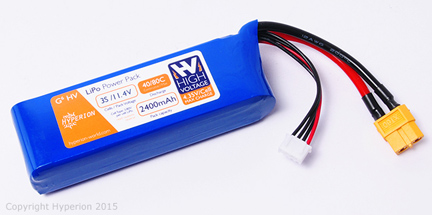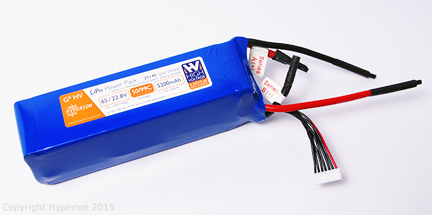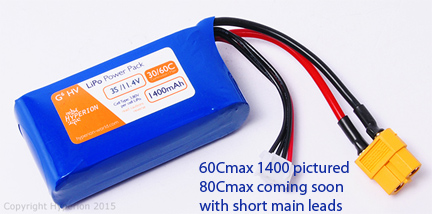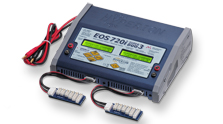

HYPERION G6 High Voltage Lithium Polymer Batteries |
|||
| The new Hyperion G6 High Voltage Lithium packs give you more power and flight time, for less money. The 2400mAh 80Cmax pack pictured at right, for example, is the same size and weight as the old 3.7V Lipo 2200 but provides about 10% more watt hours of energy. That extra 200mAh of capacity means more flight time for you, while advanced automation at our factory means lower prices than ever before. You really can have you cake, and eat it too, with Hyperion G6 HvLi packs... |
 |
||
| |||
"C" RATE PERFORMANCE |
 |
||
| PACKS for FPV QUAD RACING The G6 HvLi LiPo are awesome for FPV Quad Racing, as the extra capacity allows you to use a lighter pack. The 1200 and 1400 80Cmax have short 60mm wires and XT60 connector, to further reduce weight , inprove perfomaance, and fit without excess wire hanging out. We recommend these packs depending on size of the racer and motors employed: 80Cmax 3S and 4S 1200mAh, 1400mAh, 1800mAh for racing 60Cmax 3S 2200mAh will be excellent for FPV fun running (80Cmax 1200 and 1400 arriving June 15 2015) |
 |
||
| LIPO CARE Break-In Procedure - Hyperion packs are robust and do not need a complicated break-in procedure. Do note the other care suggestions below. These apply pretty generally to any HvLi or standard LiPo pack... Discharge - Analysis of damaged packs returned to us by users shows that nearly 70% have suffered from "capacity over-discharge" conditions. This simply means that the pack has been run too long, allowing resting voltage to fall too low. Such damage is visible upon cell inspection at the factory. Every type of battery has a minimum recommended discharge level. For example, even deep-cycle lead-acid batteries should not be regularly discharged down to less than 30%~40% of capacity. In the case of lithium polymer, to be safe always leave 20% of rated capacity in the pack at the end of a flight, with 10% as an absolute minimum.  To avoid capacity over-discharge, we recommend the setting of an appropriate cut-off voltage (LVC) and the use of a transmitter flight timer. For LVC, the appropriate voltage cut-off depends in large on how high the max and average discharge rates are. Having the Hyperion Emeter II Remote Data Logger (RDU) makes this even easier, as you can more accurately log the exact capacity mAh Out used each flight and make quick adjustments to your flight timer...  Charge - All Hyperion packs can be charged at 6C
rates, with no reduction in cycle life or performance.
However, given the negligible difference in charge time for
6C rate vs. 5C, we believe 5C to be the ideal max charge
rate for any high-performance Lipo pack. We strongly recommend the use of quality-brand charger, such
as the Hyperion EOS lineup. Hyperion holds that
4.35V/cell (+/- 0.05V) is the proper MAXIMUM terminal voltage for
Hyperion G6 packs. Use of
charge voltages higher than this (for racing, etc) is not
covered under warranty, and is dangerous. Charge - All Hyperion packs can be charged at 6C
rates, with no reduction in cycle life or performance.
However, given the negligible difference in charge time for
6C rate vs. 5C, we believe 5C to be the ideal max charge
rate for any high-performance Lipo pack. We strongly recommend the use of quality-brand charger, such
as the Hyperion EOS lineup. Hyperion holds that
4.35V/cell (+/- 0.05V) is the proper MAXIMUM terminal voltage for
Hyperion G6 packs. Use of
charge voltages higher than this (for racing, etc) is not
covered under warranty, and is dangerous.PLEASE be sure that charging is always done such that in case of fire, no damage nor injury can occur. Keep LiPo well separated (minimum 2M or 7') from flammables, and always use a brick enclosure or "LiPo sack" to insure that any possible fire can be contained. We strongly discourage charging within or near living spaces, or inside automobiles. LiPo charging should be monitored closely at all times. Temperature - For best performance and cycle life, your Hyperion battery packs should have a resting temperature no lower than 10 °C (50 °F) at the beginning of a Flight, or beginning of Charging. (this is true for any LiPo, not just G6). Physical - Never cause indentations to the covering of the pack, or cells underneath. Do not use a ball-point pen to write on the pack, for example. Use a felt-tip pen with light pressure instead. When installing packs in the model, insure that they have the best protection possible from impact and pressure damage. Use foam casing if possible. Do not over-tighten hold down straps. Straps should be cloth (velcro) as opposed to hard plastic, such as zip ties. External damage to any Lipo pack can cause salts formations which reduce performance, and in more severe cases can cause fires during charging. Impact Damaged packs should be fully discharged, and disposed of immediately. Storage - Lipo should not be stored fully charged, or with less than 50% of capacity remaining. We strongly recommend Hyperion EOS chargers, as they have automatic STORE functions to insure that the packs are in the range of about 60%~70% capacity (3.78V~3.92V resting voltage per cell). After returning home for the day, simply use STORE MODE to achieve this automatically. Batteries are best stored in a cool, dry environment (2~20 °C or 37~68 °F). |
|||
| WARRANTY COVERAGE Hyperion G3 LiPo Packs are guaranteed as follows: • Defects in materials and workmanship (solder joints, etc) for one year from date of purchase. Hyperion G3 Packs are NOT guaranteed for the following: • Physical Damage to the pack occurring after purchase (impact, water/moisture/salt, etc) • Over-voltage charging, or other error by charger or user setting of charger. • Use outside of specifications • Damage due to improper storage (very hot locations, fully charged storage, etc) • Short circuit • Improper balance connections to charger • Returns without copy of Original Receipt • Returns without accompanying note stating the reason for return. Note that a pack in which ALL cells have "ballooned" will not qualify for free warranty replacement. Given a cell failure rate of less than 1/1000, it is statistically impossible that all cells in a pack will balloon together while being properly used and maintained. In virtually all such cases, the problem can be identified over-capacity discharge, radical over-current discharge, improper storage, or charge voltage in excess of 4.355V/cell. If you have experienced this problem, you will need to troubleshoot your charger and power system, and consider how you are storing you batteries, to determine the cause, so it does not happen again. Your selling dealer is your first point of contact for warranty issues. Please contact your dealer for advice BEFORE returning any item. In many cases your dealer can help you solve a problem without return. Return postage is the responsibility of the user in all cases. You MUST Submit a copy of original, dated receipt, and explanation of the problem with the return. Returned units should be examined by the Hyperion dealer’s tech department within 10 days of arrival, and contact made with the user to explain the findings. |
|||
|
|||